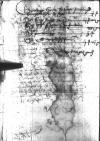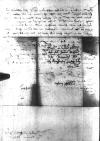Letter #5651
Paweł PŁOTOWSKI to Ioannes DANTISCUSFrauenburg (Frombork), 1539-04-07
| received [1539]-04-08 Manuscript sources:
Auxiliary sources:
| ||||||
Text & apparatus & commentary Plain text Text & commentary Text & apparatus
Reverendissimo in Christo Patri et Domino, domino
Reverendissime in Christo Pater et Domine, domine modis omnibus colendissime.
Post officiosissimam sui commendationem.
Nova, quae accepi ex
Mitto Reverendissimae Paternitati Vestrae progressum, quomodo clarissima virgo
Cum haec me et perpetua obsequia mea commendo gratiae Reverendissimae Paternitatis Vestrae. Quam Dominus Deus diu et feliciter conservare velit in optima salute bonum Deum oro.
Datum
Eiusdem Reverendissimae Paternitatis Vestrae addictissimus servitor
Postscript:
Nondum data est possessio cantoriatus venerabili domino


 AAWO, AB, D.68, f. 230v
AAWO, AB, D.68, f. 230v